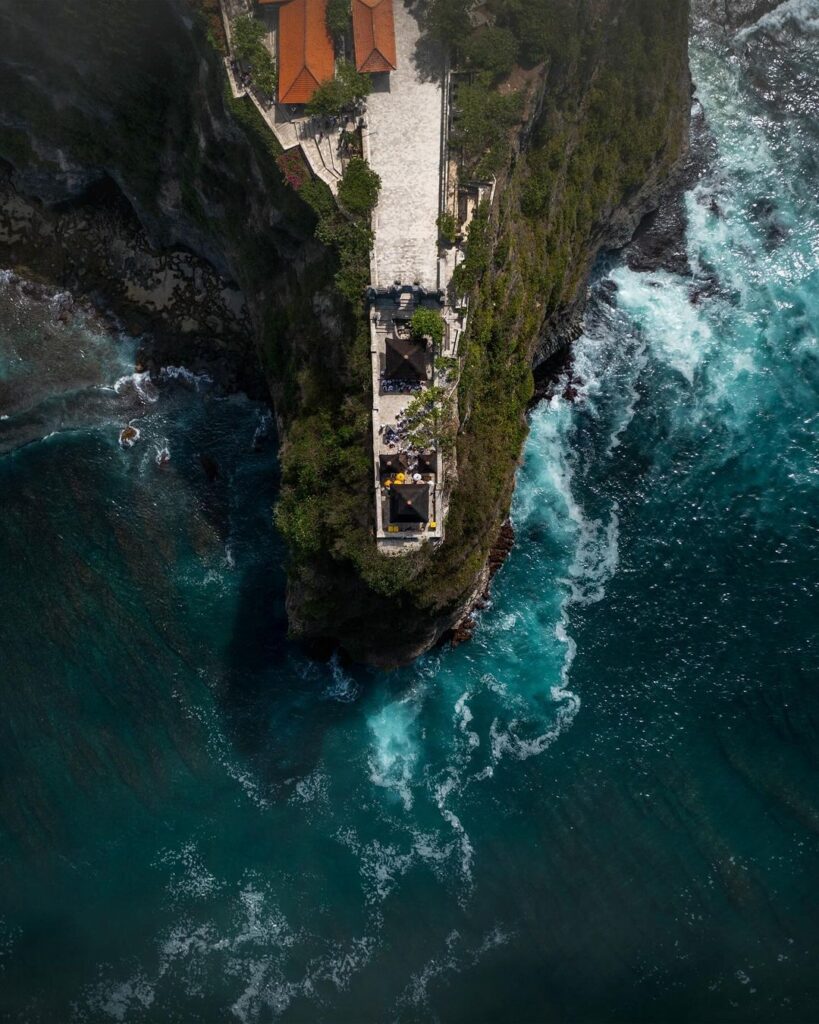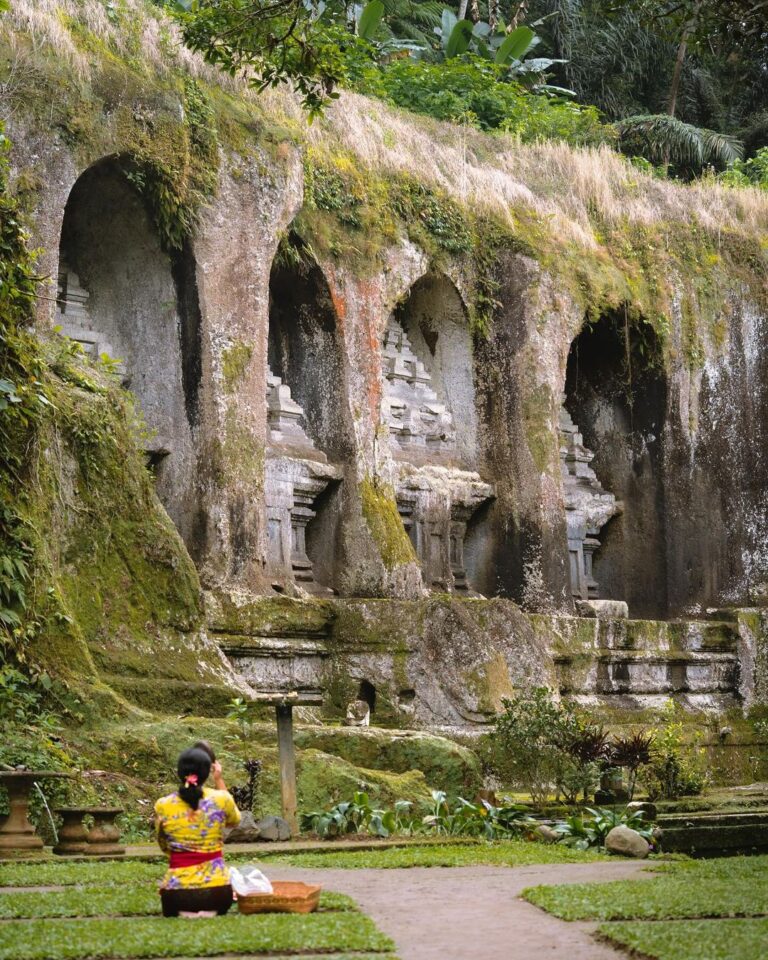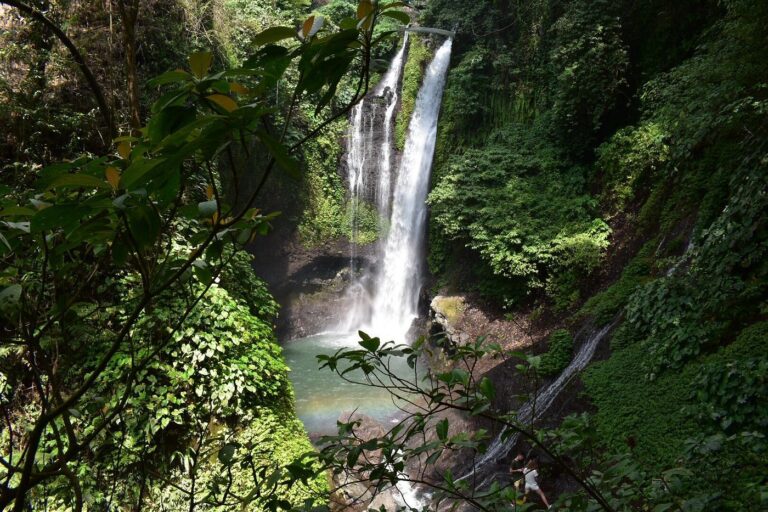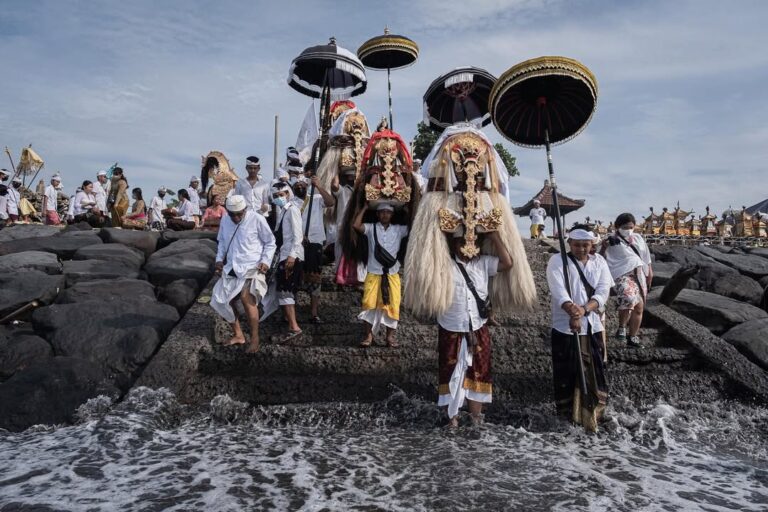The dance is based on the story of the Ramayana and is traditionally performed in temples and villages across Bali.
Most notably in the Uluwatu Temple with the performance overlooking the beautiful sunset over the horizon.
Kecak Fire Dance, known in Indonesian as “Tari Kecak”, is a form of Balinese Hindu dance and music drama that was developed in the 1930s in Bali, Indonesia.
Since its creation, it has been performed primarily by men, with the first women’s kecak group having started in 2006.

(Photo by : Alae Khaldi)
Also known as the Ramayana monkey chant, the dance is performed by a circle of as many as 150 performers wearing checked cloths around their waists, percussively chanting “chak” and moving their hands and arms.
The performance depicts a battle from the Ramayana, a Hindu epic tale in which the monkey-like Vanaras, led by Hanuman, help Prince Rama fight the evil King Ravana. Kecak has roots in Sanghyang, a trance-inducing exorcism dance.

Uluwatu Temple: Bali’s Cliffside Sanctuary Where History Meets Spectacle
Perched dramatically atop a rugged cliff overlooking the Indian Ocean, Uluwatu Temple stands as a magnificent testament to Bali’s rich history and vibrant culture.
This captivating 11th-century sea temple, one of Bali’s Sad Kahyangan (six sanctuaries believed to be Bali’s spiritual pillars), is not only a place of worship but also claimed to be the birthplace of the mesmerizing Kecak Fire Dance, an age-old tradition that draws visitors from all corners of the globe.
Uluwatu Temple’s origins remain shrouded in mystery, with estimates placing its construction sometime in the 10th or 11th century.
Inscriptions mention that Uluwatu Temple was instigated by a holy priest from eastern Java, Dang Hyang Nirartha, along with several other temples in Bali, Lombok, as well as Sumbawa.

(Photo by : Alae Khaldi)
Nirartha came to Bali in 1537 to become the chief counselor to the King of Gelgel, Dalem Baturenggong after he had left the royal courts of Blambangan Kingdom, Java.
He then chose Uluwatu Temple to be the endpoint of his spiritual journey. Devotees believe that upon arrival at the Uluwatu peninsula (Bukit), he transformed himself into a giant rock.
Splitting the land and creating a temple dedicated to warding off evil spirits from the southwest coast of Bali and reached the highest point of ‘spiritual oneness’ by a strike of lightning and vanished. The temple complex itself is a masterpiece of Balinese architecture.
Jagged black volcanic rock structures with intricately carved gates (candi bentar) guard the entrance, leading to three courtyards.
The inner sanctum, Pura Luhur Uluwatu, is the holiest shrine, perched precariously at the cliff’s edge and accessible only to priests.
Behind the main shrine in one of the courtyards of Uluwatu Temple lies a Brahmin statue facing the ocean, which is considered to be a representation of Dhang Hyang Nirartha.

(Photo by : Alae Khaldi)
The two entrances to the temple area are split gates with leaves and flower carvings. One of Uluwatu’s 10th-century relics is a one-piece winged stone gate leading to the temple’s inner courtyard.
Winged gates aren’t common on the island. The Pura Dalem Jurit temple was added in the 16th century. There are three statues inside, one of them depicting Brahma.
There are two stone troughs in the temple area. If both of them were to be joined, they would form a sarcophagus (Megalithic coffin).
The serpentine pathway to the temple is fortified by concrete walls on the cliff side. It usually takes about an hour to get from one end to another as there are several fenced points along the way where you’re surely need to take a pause.
Keepers, or monkeys believed to possess magical powers, playfully patrol the temple grounds, adding to the temple’s unique character.
Until 1983, Uluwatu Temple was hardly accessible and a lightning strike in 1999 set some parts of the temple on fire in which had undergone a series of restoration efforts since.

(Photo by : Alae Khaldi)
As the sun begins to dip below the horizon, casting an ethereal glow over the ocean, the temple comes alive with the pulsating energy of the Kecak dance.
This traditional performance, not to be confused with a typical dance, is a dramatic portrayal of the Ramayana, where dozens of bare-chested men, clad in black and white sarongs, sit in concentric circles around a central fire.
With rhythmic chants of “chak, chak, chak”, they create a mesmerizing soundscape, their voices rising and falling with the intensity of the story.
Central characters, adorned with elaborate costumes and makeup, bring the Ramayana to life, their movements accompanied by the hypnotic Kecak chorus.
The story unfolds as Rama, prince of Ayodhya, attempts to rescue his wife Sita from the clutches of the demon king Ravana.
Hanuman, the monkey god and Rama’s loyal follower, plays a pivotal role, adding a touch of humor and bravery to the epic tale.

(Photo by : El Jusuf)
The Kecak dance, with its powerful chanting, dramatic firelight, and captivating storytelling, is a truly unforgettable experience.
A Timeless Legacy: A Spiritual and Cultural Jewel
Uluwatu Temple and the Kecak dance are more than just tourist attractions; they are integral parts of Balinese culture and religious life. Witnessing a Kecak performance at Uluwatu Temple is a chance to step back in time, to experience the deep-rooted spirituality and artistic expression that defines Bali.
Practical Information for Visiting Uluwatu Temple
Location : Uluwatu Temple is situated on the Bukit Peninsula, approximately 30 kilometers south of Denpasar, Bali’s capital city.
Attire : A sarong and sash are required to enter the temple grounds. These can be rented at the entrance for a small fee.
Kecak Fire Dance : Performances begin around sunset, typically between 6 PM and 7 PM. Arrive early to secure a good spot and avoid crowds.
Respectful Behavior : As a place of worship, visitors are expected to dress modestly and behave respectfully. Avoid loud noises and refrain from pointing your feet towards the shrines.

(Photo by : Alae Khaldi)
Uluwatu Temple and the Kecak Fire dance offer a glimpse into the heart and soul of Bali.
So, come prepared to be captivated by the dramatic setting, the mesmerizing performance, and the enduring legacy of this sacred place.




